Source: nasa.gov
10-20-2007 14:59
Launch Date: 7 January 1998 UT 02:28:44 (6 January 9:28:44 p.m. EST)

Launch Vehicle: Athena II
Launch Site: Kennedy Space Center
Launch Mass: 296 kg (fully fueled), 158 kg (dry)
Power System: Body Mounted 202 W Solar Cells and 4.8 amp-hr NiCd Battery
The Lunar Prospector is designed for a low polar orbit investigation of the Moon, including mapping of surface composition and possible polar ice deposits, measurements of magnetic and gravity fields, and study of lunar outgassing events. Data from the 19 month mission will allow construction of a detailed map of the surface composition of the Moon, and will improve our understanding of the origin, evolution, current state, and resources of the Moon. The spacecraft is a graphite-epoxy drum, 1.37 meters in diameter and 1.28 meters high with three radial instrument booms. It is spin-stabilized and controlled by 6 hydrazine monopropellant 22-Newton thrusters. Communications are through two S-band transponders and a slotted, phased-array medium gain antenna and omnidirectional low-gain antenna. There is no on-board computer, ground command is through a 3.6 kbps telemetry link. Total mission cost is about $63 million. After launch, the Lunar Prospector had a 105 hour cruise to the Moon, followed by insertion into a near-circular 100 km altitude lunar polar orbit with a period of 118 minutes. In December 1998 the orbit was lowered to 40 km. The nominal mission ended after one year, at which time the orbit was lowered to 30 km. On 31 July 1999 at 9:52:02 UT (5:52:02 EDT) Lunar Prospector impacted the Moon near the south pole in a controlled crash to look for evidence of water ice - none was observed.
Editor:Liu Fang
